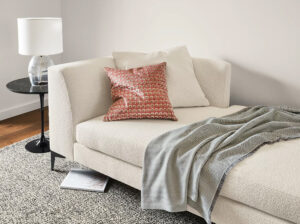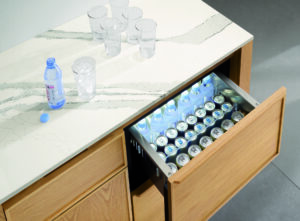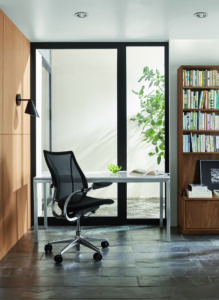Posted by Johann Nacario — August 7, 2022 — With competition for talent high, 61% of companies are investing in the design of the office, according to a recent survey from Envoy. Creating a space that truly supports all types of workers and cultivates a sense of community, creativity, focus, and well-being can be important for employee happiness and retention.
To reimagine the office as a destination that supports all types of work and work styles, Elise Nicpon from Room & Board Business Interiors (BI) outlines the top 7 spaces that every company needs for a future-focused, employee-oriented workplace. Nicpon’s list below is highlighted with some examples from Room & Board’s headquarters and projects, showcasing real-world implementations of these forward-thinking designs
1. Content Rooms
With the marketing landscape demanding more forms of consumable content, a Content Room is the new must-have space, serving as a vehicle for broadcasting all types of content. Whether it be recording podcasts, creating training videos, or filming social media clips, the Content Room is all about the backdrop and less about “traditional flow and functionality.”

 Content Room Inspiration: Room & Board partnered with San Francisco-based sneaker artists Vicky Vuong (@cestlavic) and Ann Duskus (@studioduskus) on their new studio shown above. The space serves as a multi-functional area for content creation, workshops, podcasting and filming. Featuring the Boden Leather Chair and Chilton Table. Image courtesy of R&B BI. Click to enlarge.
Content Room Inspiration: Room & Board partnered with San Francisco-based sneaker artists Vicky Vuong (@cestlavic) and Ann Duskus (@studioduskus) on their new studio shown above. The space serves as a multi-functional area for content creation, workshops, podcasting and filming. Featuring the Boden Leather Chair and Chilton Table. Image courtesy of R&B BI. Click to enlarge.
The two most important elements when it comes to designing the Content Room are dimension and flexibility. To counteract the camera’s natural tendency to flatten, vary the depths and heights of furniture from the camera. Consider high-back chairs or pieces with interesting textures and shapes to create more visual complexity and add character to your space.

 Finding furniture that allows for flexibility is also integral to the Content Room, as new projects may require different backdrops and themes. Tall shelving and bookcases like Foshay and Etting can be great solutions, as they build up vertical space and provide a blank canvas for staging and swapping props. Image courtesy of R&B BI. Click to enlarge.
Finding furniture that allows for flexibility is also integral to the Content Room, as new projects may require different backdrops and themes. Tall shelving and bookcases like Foshay and Etting can be great solutions, as they build up vertical space and provide a blank canvas for staging and swapping props. Image courtesy of R&B BI. Click to enlarge.
2. Hybrid Meeting Rooms
With 58% of the workforce being offered the option to work from home at least one day of the week, virtual meetings are a pandemic-era phenomenon that is here to stay. Staying true to its name, the Hybrid Meeting Room is a versatile space that supports everything from traditional in-person meetings to a combination of in–person and remote conferencing. Visibility, seating arrangements, and personal space are the most important features to consider to help all attendees feel comfortable and included. For example, studies indicate that circular seating arrangements, instead of rectangular, remove hierarchy within meetings, promoting inclusivity and equal participation.

 A round conference table like Julian encourages equal representation amongst employees. Another option is to swap out the conference table altogether for swivel lounge chairs, such as Otis, and laptop tables, like Slim C. Images courtesy of R&B BI. Click to enlarge.
A round conference table like Julian encourages equal representation amongst employees. Another option is to swap out the conference table altogether for swivel lounge chairs, such as Otis, and laptop tables, like Slim C. Images courtesy of R&B BI. Click to enlarge.
3. Recharge Rooms
The emphasis and prioritization of employee well-being is a trend that, thankfully, is here to stay. The “Recharge Room” is a space dedicated to all aspects of worker well-being, whether it be a space for yoga, quick naps, or a moment of solitude (plus it can also double as a private and more restorative escape for nursing mothers). Switching gears from an environment of high productivity to relaxation in the office can be difficult. Our physical spaces can greatly impact our behavior and mindset. Establish a clear and distinct break from the rest of the office using softer textures and silhouettes, ambient lighting, and warmer colors. Think upholstered sofas and chaises, along with weighted blankets, plush throw pillows, or even a high-pile rug to help channel a cozy and soothing atmosphere for relaxation.

Sterling Chaise. Image courtesy of R&B BI. Click to enlarge.

Asher Ottoman + Jonas Lounge Chair. Image courtesy of R&B BI. Click to enlarge.
4. Nature Rooms
It’s no secret that the pandemic has led to a greater appreciation of the outdoors. Bringing the outdoors in, aka biophilic design, goes beyond incorporating plants and shrubbery into the space. In addition to plant life, providing access to natural light, including natural features like stone and wood, and embracing color are all biophilic design principles that have been proven to reduce stress, enhance mood, and improve creativity and productivity. Atriums with an abundance of glass windows are a popular choice for funneling natural light into central areas.

Room & Board’s headquarters feature a wraparound design that allows a gorgeous view of the center courtyard and lush vegetation from all four angles within the office. Image courtesy of R&B BI. Click to enlarge.
Indoor gardens are also trending due to their physical and mental benefits. Not only do indoor gardens add beautiful design elements that participate in solving common spatial problems, but they also aid in room acoustics and improve worker well-being.

Room & Board’s atrium, located in the brand’s Minneapolis HQ, provides a space for workers to reconnect with nature – at any time of the year (especially during Minnesota’s cold winters). Minimalist wood benches that wrap around the perimeter provide ample space for sitting, socializing, and nature bathing. Image courtesy of R&B BI. Click to enlarge.
In addition to bringing nature into the office, take the office outdoors. Access to the outdoors has become an increasingly desired amenity among employees, resulting in more courtyards, balconies, and rooftops being incorporated into the design of commercial buildings. The daylight and fresh air offer a healthy and stimulating workspace, a calming environment to relax, and even a change of scenery for meetings and presentations.

Room & Board’s outdoor courtyard features Emmet Chairs, covered seating spaces, and heating for colder days. Image courtesy of R&B BI. Click to enlarge.
5. Comfortable Community-Centric Rooms
The office should foster the creation of experiences that are rarely encountered when working from home – connection, engagement, and collaboration. Carving out a dedicated community space with comfortable lounge seating where employees can regroup, grab a cup of coffee, and connect can help stimulate relaxed, impromptu collaboration and strong workplace culture.

 The Amherst cabinet’s discreet refrigeration from True to store beverages and snacks is perfect for a community space, as it draws employees in for a quick snack and lounge break with one another. Images courtesy of R&B BI. Click to enlarge.
The Amherst cabinet’s discreet refrigeration from True to store beverages and snacks is perfect for a community space, as it draws employees in for a quick snack and lounge break with one another. Images courtesy of R&B BI. Click to enlarge.
Like the Recharge Rooms, the design and decor should reflect the intention of the space, with a focus on comfort and gathering. Our environments subconsciously influence our behavior, and furniture plays an important role here, so think lounge-like feel to encourage casual conversations and restoration. The community space should be a place where employees want to hang out.

The new Fia Sectional (available 8/16) provides ample seating while considering the need for personal space. Perfectly paired with the Nyla End Tables, Nyla’s hollow interior and three size options make it extremely versatile as it’s easy to move around and can function as a table for a laptop or to eat a small meal, a stool for extra seating, or an ottoman to rest your feet on.
Image courtesy of R&B BI. Click to enlarge.
6. Focus Rooms
It is important not to neglect the original purpose of the office as a space for productivity and work. To accommodate those who typically prefer working from home to avoid common office distractions and background noise, create a library-like space for heads-down focus. The Focus Room serves as the perfect counterpart to collaboration spaces, giving employees the option to zone in on work and research without being disturbed.
While the idea may seem counterintuitive, opt for larger communal “work” tables that mimic the library layout. Studies on social identity theory show that engaging in a shared workspace creates a sense of group identity, prompting more awareness of others. In this case, the library effect makes workers more inclined to keep noise levels down so as not to disturb others.

Super versatile and endlessly customizable, Parsons Tables can be pushed together to form a library table for collaborative work. Image courtesy of R&B BI. Click to enlarge.
7. Home Rooms
87% of employees that are offered remote work spend an average of three days working from home each week. To fully support workers in and out of the office, on top of providing them with a thoughtful commercial office space, it’s important to equip them with a proper work-from-home (WFH) setup, too. A comfortable, ergonomic workspace encourages productivity and promotes well-being. Although not in an actual office, home office furniture needs the same quality and durability as commercial spaces to withstand wear and tear from pets, children, and everyday use.


 Merging modern design with ergonomic comfort, newly available at Room & Board Business Interiors, both the Liberty Ocean Office Chair and Path office chairs are ergonomically designed seats. The Mosby Armoire, which features a drop-down desk and plentiful storage, is the perfect workspace for small spaces – paired with the Lira chair, which is now available with new upholstery options. Image courtesy of R&B BI. Click to enlarge.
Merging modern design with ergonomic comfort, newly available at Room & Board Business Interiors, both the Liberty Ocean Office Chair and Path office chairs are ergonomically designed seats. The Mosby Armoire, which features a drop-down desk and plentiful storage, is the perfect workspace for small spaces – paired with the Lira chair, which is now available with new upholstery options. Image courtesy of R&B BI. Click to enlarge.




